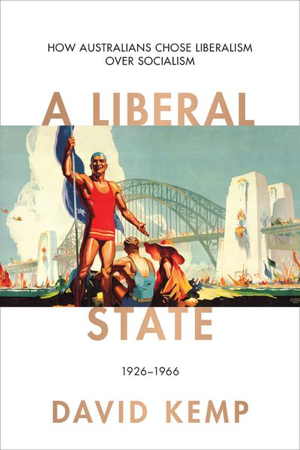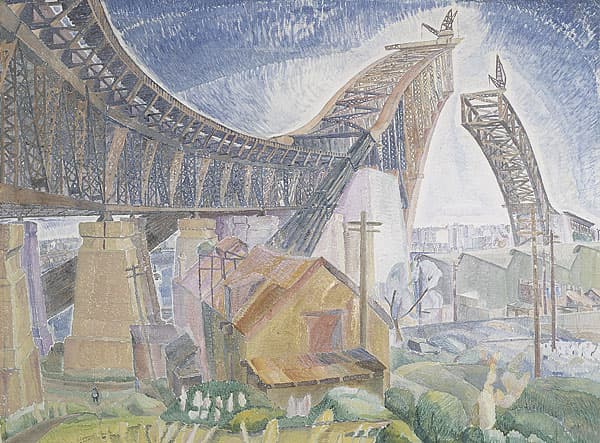[Note: This post is part of a series on the History of the Classical Liberal Tradition]
Some conservative/liberal groups in Australia have adopted a slogan first used in the US, namely the “Australian Way of Life” modeled on the notion of the “American Way of Life”. It implies that such an “Australian” way of life was and possibly still is a “liberal” one, when in fact, if there is anything such as “the” Australian way of life (which I doubt) it is more likely to be a socialist, statist, or paternalistic one. Or “progressive” in modern parlance.

The idea of an implied “liberal” “Australian way of life” has become part of the Institute of Public Affairs’s mission and sense of itself, and hinted at most recently in the party platform of the newest Australian political party with the very awkward and oddly name of “Australia’s Representatives” (or “AusReps”). I think this is unfortunate and misleading because it fudges over significant issues of Australia’s very un-liberal heritage and history, especially its founding as a penal colony in 1788 and its national founding as a “progressive” and socially “advanced” state in 1901. (In addition, we should mention the founding of an explicitly “Liberal Party” in 1944 by Robert Menzies et al. which I would describe as “LINO” or “liberal in name only” rather than a “true” classical liberal party (free trade anyone?), but this is the topic for another post.)
The “American” Way of Life
The adoption of such a statement, “to maintain and enhance the Australian Way of Life”, with the implication that Australia’s “way of life” was then and is now (or should be now) a “liberal” one, might have made some sense in America where the founding of the American nation state was a product of a war of liberation against the British Empire, a successful act of secession from an irresponsible tax regime, and the writing of a new constitution based upon ideas of natural rights to life, liberty, and property (with the obvious very un-liberal proviso that it did not apply to black slaves). Even in America, there were some “original sins” against liberal principles committed by the “founding fathers”, such as the attempt to dismantle the truly decentralized and “con-federative” nature of the Articles of Confederation and impose a much more centralized national state with a president with powers more like an elected monarch, with growing powers of taxation, the creation of a National Bank and a “national debt”, and economic policies which necessitated considerable state intervention (the so-called “American System” of Hamilton and Clay), and then the high tariffs of the late 19th century.
But the unravelling of the “liberal” (in the “classical” not the modern American sense) “American way of life” accelerated in the 20th century with the creation of the Empire (after the Spanish-American War), the creation of the foundations of a welfare state under FDR in the 1930s and Johnson in 1964, and a massive “national security state” during and after WW2. Now, what remains is what I call a kind of “folk libertarianism” where the rhetoric of individual liberty is still part of public discourse but it has been largely emptied of much content and meaning under these very changed circumstances.
The Manifold “Original Sins” of the Founding of “Liberal” Australia

In my opinion Australia, by contrast, was founded in a state of “origin sin” against liberal principles, or rather several waves of “original sin”, in spite of the claims to the contrary by David Kemp in his multi-volume history of “A Liberal Nation”. [On the rather jarring juxtaposition of statist and liberal images on the cover of this volume, see below.] “Australia, or rather “New South Wales,” began as a military penal colony based upon the principles of a labour camp, with minimal voluntary labour or exchange relations between individuals which were limited to the small but growing number of “free” settlers and not the convict “forced laborers”, a form of military socialism where the governor and military officers controlled the store of provisions with all the problems of a “command economy” or what Mises called a “Zwangswirtschaft”, and a system of land ownership where the entire continent had been claimed as “the property” of the crown, or what I would call a kind of “monarchical or crown communism.” This control of land by “the crown” resulted in the legal and practical dispossession of the native inhabitants and the creation of a system of “crony” land ownership by means of land grants, sales, long-term leasing, and so on. There was the practice of “squatting” on tracts of land, or what the Americans termed “homesteading” which was the established liberal “Lockean” way in which unowned land was converted by use and occupation (“mixing one’s labour” with the soil) into justly owned and legitimate private property. However freehold title was not the most common form of land ownership and the system of “crown land communism” especially in mining leases is still the common practice in Australia.
By the mid-19th century the colonies began to get some tokens of self-governance (what I would call some aspects of “political liberalism” with the development of colonial legislatures) but this was limited throughout the rest of the century and well into the 20th after so-called “independence” by Imperial control of foreign and military policy which meant that Australia never became a truly independent country or nation like the US until after WW2. This very limited form of liberalism in Australia was based upon the “new” liberalism which had emerged in Britain (Hobhouse and Green) which had dramatically revised the more “radical” kind of liberalism which was the foundation of the actions of reformers like Richard Cobden in the 1830s and 1840s. The “antipodean” form of liberalism which was prevalent in Australia in the late 19th century was defined by extensive government involvement in the ownership and supply of key infrastructure activities like ports, railways, and other public transport (trams), as well as grain storage and delivery. This was described at the time quite correctly as “colonial socialism” and to this was added from “the left” the very unliberal views of the “labour movement” which resulted in the formation of the Labor Party in the last decade of the 19th century.
One should also mention the great split which had emerged as industrialization took place between the supporters of liberal free trade (concentrated in Sydney) and un-liberal protectionism (concentrated in Melbourne). The success of the protectionists in getting their policy adopted as a cornerstone of the economic policy of the new “Commonwealth of Australia” in 1901 added to the growing list of “original sins” against liberal principles which lay at the very heart of the “new nation”: this included compulsory wage arbitration, the exclusion of certain races from immigrating (the “White Australia Policy”), continued government ownership and control of significant infrastructure, and soon after Federation the adoption of a country-wide land tax which evolved into an income tax. Given these activities, it is not surprising that Australia at the beginning of the 20th century had one of the highest levels of government spending and taxation as a percentage of GDP of the more advanced economies in the world, possibly twice that of the US. For this and other reasons Australia was commonly regarded as an advanced “progressive” country where the practicality and desirability of many socialist principles were being showcased as an example for the rest of the world, which would follow in due course.
One might also add to this toxic brew of government interventions that of the willingness of many Australians to get involved in foreign wars which posed no direct threat to Australia but were directly connected to maintaining the power and prestige of the British Empire. I have in mind the Boer War in South Africa (another war of independence the British opposed) and the First World War which one might describe as a brawl between European Empires which Australia would have been well advised to avoid. To the “myth of a liberal Australian way of life” might be added that of “the myth of ANZAC” which was the way many Australian’s judged themselves as “fit” to be a (semi-)independent nation by their prowess to wage war and kill other people, admittedly as stoically as possible under considerable hardship.
The 20th Century: LINO (liberal in name only)
The history of the growth of the state and its increasing intervention in the economy and over people’s individual lives throughout the course of the 20th century is only another long and very sad chapter in the history of liberal Australia which I cannot go into here in any detail. I have limited my remarks in this post to the “original sins” of Australia’s foundation and not their subsequent development and expansion. But one could conclude from this brief history that contemporary classical liberals/libertarians cannot get any solace in talking about “the Australian way of life” if by this they mean a “liberal” way of life. To paraphrase Robert Menzies and John Howard, the truly “forgotten people” of Australia are not the ordinary taxpayers and “battlers”, but the small handful of true or radical liberals who have popped up from time to time in Australia’s history, disappeared, and then promptly forgotten. [See my collection of some of these “forgotten” true Australian classical liberals and libertarians here. I have also put online Menzies’ radio “fire-side chats”, including “The Forgotten People” talk of May, 1942.]
Note on the “socialist” Sydney Habour Bridge vs. the “liberal” Surf Life Saving Association
The front cover of David Kemp’s third volume of his history of liberalism in Australia – A Liberal State: 1926-1966. How Australians chose Liberalism over Socialism (Melbourne University Press) – has a jarring juxtaposition of images which goes some way in explaining the strange and conflicted nature of “antipodean liberalism”. In the background there is the iconic image of the Sydney Harbour Bridge (completed 1932) which is statist and illiberal in its funding and its construction; and an equally iconic image (in the foreground) of a member of the Surf Life Saving Association which is a private and volunteer association and hence very liberal in its significance.

The Bridge in Curve (1926) painting by Grace Cossington Smith
The Sydney Harbour Bridge was built by a government body (the NSW Dept. of Public Works) and funded by taxpayers (and tolls) rather than by a private firm using its own funds. It cost A£6.25 million and required the coercive confiscation of over 400 private homes and commercial buildings without adequate compensation. It then took 56 years to pay off the loans incurred to build it (1932-88). It thus is a symbol of the worst features of government intervention in the economy (also broadly known as “socialism”). See Sydney Harbour Bridge – Wikipedia

In the foreground we see figures dressed in the distinctive clothing of the privately funded and voluntarily organized Surf Life Saving Association. In “liberal Australia” in 1902 it was illegal for anybody to go into the ocean during daylight hours! Only after this illiberal and prudish law was challenged in the courts that surfing and surf swimming became popular and the need for surf life saving clubs appeared. The Surf Bathing Association of New South Wales was formed on 18 October 1907. I would argue that the SLSA is thus a symbol of the best features of a voluntary, free market society (also known broadly as “liberalism”) and that the image sits rather jarringly in font of the Sydney Harbour Bridge on the cover of the book. See Surf Life Saving Australia – Wikipedia
However, I’m sure Kemp is not asking us here to make a choice between the “socialism” of the Sydney Harbour Bridge and the “liberalism” of the Surf Life Saving Association. Rather, he seems to think that the two go together seamlessly as part of the one “liberal state”. A view I do not share.
